Exploring the Depths of Healing Crystals


Intro
In a world where natural wonders often captivate us, gemstones hold an extraordinary fascination. These vibrant minerals, often found nestled in the earth's crust, are more than just decorative items. They tell stories of ancient practices, hold potential healing properties, and have become cornerstones in various cultural and spiritual realms. As we embark on this exploration of gemstones, specifically healing crystals, it is vital to articulate their multifaceted nature, encompassing history, metaphysics, and practical applications.
Gemstone Overview
Definition of Gemstones
Gemstones, by their very essence, are mineral formations that have been valued for their beauty, rarity, and durability. Typically crafted into adornments or used in spiritual practices, they come in a plethora of forms and types. Their classifications stem from a blend of properties: mineral composition, transparency, color, and the specific treatments applied to enhance their appearance.
Classification of Gemstones
Gemstones can generally be divided into two main categories:
- Precious Stones: These are the heavyweights of the gemstone world – diamonds, rubies, sapphires, and emeralds. Their beauty, rarity, and historical significance elevate them to esteemed status.
- Semi-Precious Stones: While perhaps not as illustrious, semi-precious stones such as amethyst, turquoise, and quartz bring their own unique charm and healing attributes.
Understanding the classification helps enthusiasts make informed choices about their collection and make sense of the vast universe of gemstones.
Historical Significance
Origins of Gemstone Use
The use of gemstones dates back thousands of years; ancient cultures revered them not merely for their aesthetic appeal but also for their purported mystical properties. Evidence suggests that as far back as 4000 BC, gemstones were utilized in jewelry and amulets, believed to protect and bring good fortune. The allure of healing crystals seeped into early civilizations, from the Egyptians who adorned their tombs with lapis lazuli to the Greeks, who utilized amethyst to ward off drunkenness.
Cultural Insights: Gemstones in Ancient Civilizations
In ancient India, gems played a crucial role in astrological beliefs, each stone linked with celestial bodies. Similarly, the Chinese viewed jade not only as a symbol of purity but also as a protective stone against evil spirits. Across the board, gemstones have imbued people with a sense of spirituality and connectedness to the earth. Their stories are interwoven with human history, transcending time and cultures, and they continue to find relevance today in practices ranging from alternative healing to modern jewelry design.
"Gemstones are the earth's poetry, a narrative carved in stone that speaks of the ages."
As we unravel the intricate details of healing crystals, their historical significance sheds light on not just their past but also their potential in contemporary contexts, inviting exploration and understanding.
A delicate balance exists between historical reverence and modern-day applications, allowing gemstone enthusiasts, collectors, the designs of jewelry, and geology aficionados to appreciate the rich tapestry woven by these natural creations.
Intro to Healing Crystals
Healing crystals have carved a unique niche in both historical practices and modern wellness routines. These natural gemstones, revered for their potential to foster healing and promote balance, have not only intrigued enthusiasts but also sparked extensive debate in scientific circles. What lies at the heart of this fascination? At first glance, one might simply see beautiful minerals, yet each crystal brings with it a tapestry of cultures, beliefs, and stories. In this article, we aim to peel back the layers of these stones to understand their significance in context and application.
Utilizing crystals can be more than just a aesthetic pleasure. Many believe that these gems have the power to influence emotional states and enhance spiritual connections. For instance, a person may turn to amethyst for tranquility, while someone else might choose rose quartz to encourage love in their life. The array of benefits these minerals are thought to confer is vast, making them a popular choice among those seeking alternative healing avenues.
However, as fascinating as these beliefs are, a critical understanding is essential. Prospective users should be well-informed about the historical roots, the distinctions among various crystals, and their associated metaphysical properties. Ignorance of the basics can lead to poor selection and ineffective use, which may undermine one's aspirations for healing.
Furthermore, caring for your crystals is an art form in itself. Proper cleansing and storage techniques dictate how effectively one might harness the energies these stones purportedly offer. The crystal is not just a passive object; it requires attention and intention.
"The crystal only works as well as the energy you bring to it."
In considering the importance of this topic, we must also address the modern shift towards combining science and spirituality. Many now seek evidence-based practices while still valuing the intangible qualities these stones represent. Thus, the realm of healing crystals becomes a fascinating intersection of age-old traditions and contemporary scientific inquiry.
Historical Context of Crystals
The exploration into the historical context of crystals serves as a foundation for understanding their multifaceted roles throughout time. Healing crystals have influenced cultures around the world, spanning centuries and generations. Their application not only reveals the beliefs and practices of ancient civilizations, but also sheds light on the ongoing fascination with these stones today. By examining the historical backdrop, one can appreciate the depth of their significance in various contexts, which adds richness to the contemporary practice of crystal healing.
Ancient Cultures and Crystals
Egyptian Use of Crystals
In ancient Egypt, crystals were revered not merely for their beauty but for their perceived powers. The Egyptians believed that stones like lapis lazuli, turquoise, and carnelian held spiritual significance. These gemstones adorned the tombs of the pharaohs and were often placed with the dead to provide safe passage into the afterlife. The key characteristic of such practices was the Egyptians' strong belief in the metaphysical properties of these crystals, which they thought could invoke protection or healing.
A unique feature of the Egyptian use of crystals is their meticulous craftsmanship in making amulets and jewelry with specific stones. Such items were not only decorative but also functional, believed to act as talismans against negative forces. While this belief may seem unscientific by modern standards, it illustrates a cultural understanding of energy and vibrations that resonates with today’s metaphysical perspectives.
Chinese Medicine and Gemstones
In contrast, Chinese medicine has integrated crystals into a holistic framework. Gemstones play a significant role in traditional Chinese medicine, where they are often used alongside acupuncture and herbal remedies. The key characteristic of this practice lies in the belief that crystals can channel life force, or Qi, to promote healing and wellness.
A unique aspect of Chinese crystal therapy involves the use of specific stones corresponding to different organs or health needs. For example, jade is highly esteemed and is thought to promote longevity and harmony. However, there are also considerations; practitioners must understand the delicate balance in utilizing crystals alongside other treatments to avoid conflicting energies.
Indigenous Traditions
Indigenous cultures worldwide have a rich tapestry of beliefs regarding crystals, treating them as sacred objects. From Native American traditions that honor stones as ancestors or spirits to Aboriginal Australians who use minerals in rituals, these practices reveal an intrinsic connection between people and the earth. The key characteristic here is the role of crystals as teachers, guiding individuals toward healing and enlightenment.
One distinct feature of indigenous traditions is their emphasis on the energetic connection of crystals with nature. This deep-rooted respect provides context for their use in ceremonial practices. The challenge, however, lies in ensuring that modern interpretations of these practices respect the original cultural meanings and significance, lest they become commodified.
Renaissance Practices and Beliefs
Alchemy and Gemstone Lore
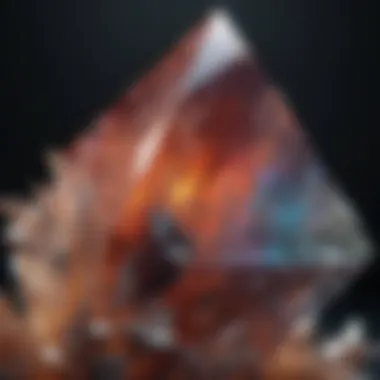
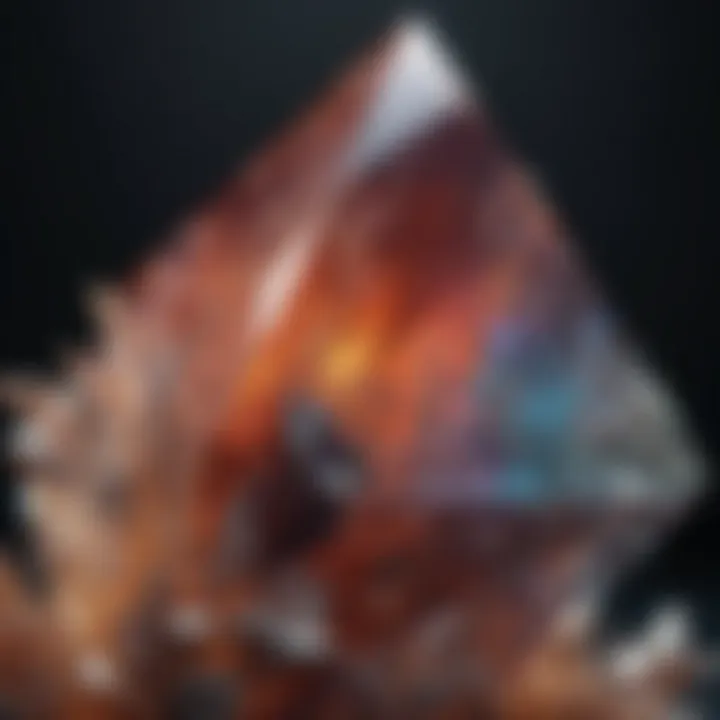
During the Renaissance, alchemy experienced a resurgence, intertwining with the lore of gemstones. Alchemists viewed crystals as not only instruments for transmutation but also symbols of purity and spiritual enlightenment. The key characteristic of this period was the amalgamation of science and mysticism, where crystals were seen as conduits for achieving higher states of consciousness.
Alchemy's unique feature includes the conceptualization of various crystals as representing different elemental forces. For instance, quartz might symbolize clarity, while diamonds reflected purity. This philosophical allegory contributed to the persistent allure of crystals even in modern metaphysical practices, albeit with a more polished understanding of their energies.
Crystals in Medieval Medicine
Medieval medicine further legitimized the use of crystals in treatments. Physicians often partnered medicinal herbs with crystals in remedies, believing in their curative properties. The key characteristic of this practice lay in their holistic approach, aiming to treat not just the body but also the spirit.
A unique aspect of this integration was how crystals, such as amethyst for treating insomnia or garnet for blood purification, were seen as essential companions to herbal tinctures. However, it is important to note the potential missteps when non-scientific methods resulted in neglecting more effective medical practices.
Influence on Modern Esotericism
Finally, the influences from the Renaissance period paved the way for modern esotericism. The ideas about crystals as powerful tools for healing and transformation have persisted, evolving alongside spiritual movements. The key characteristic here is the blending of historical wisdom with contemporary spiritual practices.
A notable unique feature is how this influence has broadened the appeal of crystals, leading to their embrace in various modern communities seeking alternative healing methods. Nonetheless, as interest grows, there lies an ongoing challenge: distinguishing genuine practices from fad trends that commoditize these powerful stones.
"To understand the full spectrum of a crystal’s power, one must look back to the history that shaped its very essence."
Through contemplating the historical context, it becomes clear that healing crystals are more than mere objects; they embody centuries of cultural heritage, scientific inquiry, and spiritual exploration, which continue to enrich our interactions with these stones.
Understanding Metaphysical Properties
When we delve into the realm of healing crystals, we cannot overlook the significance of metaphysical properties. These properties, often regarded as the essence or spirit of the crystals, are believed to possess an influence on our physical, emotional, and spiritual well-being. Understanding these properties is essential for anyone looking to harness the potential benefits that these natural formations offer.
The relationship between specific crystals and their metaphysical applications can vary widely, influenced by historical context and cultural beliefs. Crystals are often thought to resonate with the vibrations of the universe and have unique attributes that can affect the chakras, which are energy centers in our body. The implications of these properties extend beyond mere belief; many users report profound personal experiences that can promote healing, balance, and clarity in their lives.
There’s a robust tradition of pairing crystals with the chakras—root, heart, and crown—each serving distinct and essential roles in our existence. Grasping these nuances encourages a more focused approach when selecting crystals, as one can match specific stones to personal goals or emotional needs.
"The energy of the universe intertwined with the vibration of the crystals can be a guide to self-awareness and healing."
Crystals like amethyst, rose quartz, and black tourmaline are just a handful of stones associated with particular metaphysical properties. Users often seek them out to address specific challenges, like anxiety, emotional trauma, or spiritual disconnect. Thus, a profound understanding of these properties not only informs practitioners but also enriches their journey into self-discovery and healing.
Root Chakra and Grounding Stones
The root chakra, located at the base of the spine, is fundamental for grounding and stability. When this energy center is in balance, individuals typically feel secure and reliable. Grounding stones, such as hematite and red jasper, are often used to anchor the energy of the body. These crystals can help individuals reconnect with the physical world and build a solid foundation for emotional resilience.
Hematite, known for its metallic luster, is often said to transmute negative energies into positive ones. It encourages a sense of safety and practicality, ideal for those feeling unsteady in chaotic situations. Similarly, red jasper fuels physical vitality and passion, stimulating the senses and inspiring action. This important feedback loop of stability can create a sanctuary for emotional healing.
Heart Chakra and Emotional Balance
The heart chakra governs our ability to love and be loved while also serving as the bridge between our physical and spiritual essence. Crystals aligned with this chakra—like rose quartz—are often sought for their soothing properties. Rose quartz isn't just pretty; it’s the stone of unconditional love, known for nurturing emotional balance, self-acceptance, and compassion.
Moreover, crystals like green aventurine can open up pathways for emotional healing and promote a sense of calm. Many enthusiasts advocate using these stones during meditation to cultivate feelings of love and gratitude. Their gentle vibrations encourage healing emotional wounds, allowing users to release past grief and embrace new beginnings, making them especially vital in relationships and community ties.
Crown Chakra and Spiritual Connection
The crown chakra, found at the top of the head, serves as our channel for divine consciousness and spiritual connection. When this chakra is aligned, individuals often experience a state of pure bliss and heightened awareness. In this space, crystals like clear quartz and amethyst shine exceptionally bright.
Clear quartz is often referred to as the 'master healer.' Its versatility allows it to amplify the effects of other crystals, while its clarity aids in spiritual insight. Meanwhile, amethyst resonates with a calming energy, fostering intuition and peace, making it perfect for meditative practices.
Connecting with these stones aids many in navigating their spiritual paths, promoting deeper reflection and understanding of life's greater mysteries. This connection can lead to valuable insights, helping individuals to align their lives more closely with their true purpose.
In summary, understanding the metaphysical properties of healing crystals necessitates exploring the depths of one’s self and the energies surrounding us. Each chakra plays a vital role in our personal development, and choosing the right stones may unlock pathways that were previously untraveled. As we journey through the world of crystals, we begin to uncover the potential that lies within us and the universe.
Scientific Perspectives on Healing Crystals
Understanding the scientific perspectives surrounding healing crystals provides a more rounded view of their influence and application in both holistic and traditional practices. This topic is crucial because it bridges the gap between empirical research and ancient wisdom. It's not just about the mystical properties attributed to these stones; it also includes exploring their actual physical and psychological effects, which offers valuable insights for both enthusiasts and skeptics alike.
The Placebo Effect in Crystal Healing
One of the most frequently discussed concepts in the realm of healing crystals is the placebo effect. This phenomenon indicates that a person's belief in the efficacy of a treatment can indeed lead to positive emotional or physical changes, even if the treatment itself lacks inherent therapeutic properties. When it comes to healing crystals, the belief in their power can lead individuals to experience perceived benefits simply by being in their presence or by incorporating them into their routines.
Recent studies underline the influence of mindset on wellness outcomes. For example, when someone believes a specific crystal can alleviate stress or promote creativity, this belief might trigger positive psycho-physiological responses. This understanding doesn't diminish the value of crystals; rather, it highlights the complex interplay between the mind and body, lending credence to alternative healing practices.
Mineral Composition and Physical Properties
Crystal Structures and Energy
Crystal structures hold a significant role in understanding the energy attributed to healing crystals. Each crystal type exhibits a unique arrangement of atoms, resulting in different properties. For instance, quartz has a hexagonal structure that is believed to facilitate energy flow, making it a popular choice in meditation practices and spiritual work.
The idea that the atomic lattice of a crystal can influence energy transfer is beneficial, as it offers a scientific layer to the discussion surrounding healing properties. The orientation and size of the atoms in a crystal lattice can create specific vibrational frequencies. These characteristics are often cited as reasons why certain crystals, like amethyst or citrine, are favored for particular intentions, such as protection or abundance. However, the energy projection of crystals is still under debate, as empirical evidence remains limited.
Thermal and Electric Properties
When considering thermal and electric properties, it becomes evident that these characteristics can also inform our understanding of crystals. Certain crystals, like tourmaline, are known to exhibit pyroelectricity, meaning they can generate an electric charge when subjected to temperature changes. This unique feature is not just intriguing but also highlights how environmental factors can impact crystalline behavior.
The thermal properties of crystals also play a part in various healing modalities. For example, some enthusiasts argue that heated stones can influence body temperature and promote circulation, potentially enhancing the calming effects of a healing session. However, while these properties are fascinating, much of the discussion remains theoretical and is yet to be fully validated through rigorous scientific research.
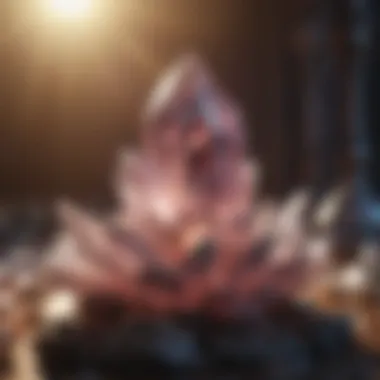

Psychological Effects of Color and Light
Crystals come in a plethora of colors; their visual appeal is undoubtedly one contributing factor to their popularity. Colors can evoke emotions and influence psychological states. For instance, the calming blue of lapis lazuli might promote tranquility, whereas the vibrant yellow of citrine could inspire energetic thoughts.
Light can also play a role in how we perceive crystals. The way light refracts through a stone can create unique effects, further enhancing its allure and perceived energetic qualities. Thus, the psychological effects of color and light not only contribute to the aesthetic appreciation of crystals but also delve deeper into their potential as tools for emotional and spiritual well-being.
"The beauty of crystals lies not only in their physical form but also in the way they resonate with our own energies and emotions."
Practical Applications of Healing Crystals
In the landscape of contemporary wellness and personal development, healing crystals have emerged as valuable tools. Their practical applications extend beyond mere aesthetics, tapping into emotional, mental, and spiritual enhancement. The importance of this topic lies in its ability to bridge ancient wisdom with modern practices. By understanding how to implement these crystals in daily routines, enthusiasts can not only elevate their spiritual practices but also cultivate a deeper sense of mindfulness.
Meditation and Mindfulness Practices
Using crystals during meditation can deepen the practice significantly. When one selects a specific crystal with desired properties—be it amethyst for calming energy or rose quartz for love—it can influence the meditation experience profoundly. Here’s how this works: as you sit in silence, holding the crystal or placing it nearby, the specific vibrations may align with your intentions, allowing for a clearer path toward focus and tranquility. During meditation sessions, many practitioners report an enhanced connection to their emotions, making them feel more in tune with themselves. This aspect of crystal use becomes especially significant for those on a journey of self-discovery or facing mental challenges.
Incorporating Crystals into Daily Life
Integrating crystals into one's life can be both simple and transformative. Besides meditation, there are various ways to incorporate these stones so their benefits can permeate everyday activities. Below, we delve into two notable methods: wearing and carrying crystals, as well as creating crystal grids.
Wearing and Carrying Crystals
The act of wearing and carrying crystals stands out as a popular method among devotees. Not only does it make the benefits of crystals easily accessible, but it also allows for a continuous energy exchange throughout the day.
- Personal Energy Boost: Wearing a crystal as jewelry or keeping one in a pocket can serve as a wearable reminder of your intentions, thus acting as a kind of emotional anchor.
- Empowerment On-The-Go: The unique feature of this practice is its seamlessly convenience—whether at work, home, or outside, the wearers maintain a connection to their intentions and can invoke the crystal's properties (like protection, clarity, or peace) throughout their daily routines.
While beneficial, it is worth noting that the energies might feel overwhelming to some, particularly for those who are new to crystal work. As with anything, personal comfort levels should guide how often and in what capacity one wears or carries these stones.
Creating Crystal Grids
On the other hand, creating crystal grids is a more advanced and purposeful application of healing crystals. This method involves arranging multiple crystals in a specific geometric pattern, which is believed to amplify their energies and direct them toward a chosen intention such as healing or manifestation.
- Nurturing Intentions: The intricate structure of a crystal grid symbolizes sacred geometry, which many believe enhances the synergy of the crystals involved. By focusing energy through this configuration, practitioners may find their intentions manifesting more readily.
- Collaboration of Crystals: Each type of crystal brings unique properties to the grid, which can complement or enhance one another, allowing for a richer experience. For example, combining selenite for clarity with clear quartz for amplification can create a powerful tool for manifestation.
However, creating effective grids may require more knowledge, as one must understand how the energies of different stones interact. Enthusiasts should take time to learn about various layouts and combinations to maximize the effectiveness of their grids.
In summary, understanding the practical applications of healing crystals not only enriches personal practices but also fosters a sense of community among users. Whether it’s incorporating crystals into meditation or daily life, these practices, when approached with mindfulness, can lead to profound growth and transformation in one’s spiritual journey.
Choosing the Right Crystals
Selecting the right crystals for personal use or collection is arguably the most crucial step in integrating their benefits into one’s life. It’s not just about picking a pretty stone from the local shop; there are various facets to consider that can enhance, or even diminish, the intended effects. Understanding which crystals resonate with your personal energies is the key. Crystals are not one-size-fits-all items. They come in myriad types, colors, and structures, each carrying distinct attributes and healing potentials. By being informed and intuitive, individuals can craft a personal relationship with their chosen stones. For example, a crystal that might bring tranquility to one person may resonate entirely differently for someone else.
Intuitive Selection Techniques
When it comes to choosing crystals, intuition plays an indispensable role. Many enthusiasts suggest that the most effective method is to rely on one’s instincts rather than solely on research or recommendations. Try to visit a crystal shop and observe how certain stones make you feel. Here are some simple ways to tap into that intuition:
- Visual Cue: Sometimes, the colors or patterns in a crystal can be incredibly appealing. If something catches your eye, there’s often a good reason for it.
- Meditative Approach: Meditate briefly and ask for inner guidance about what you need. After this, revisit the crystals and see if your preferences shift.
By engaging these intuitive methods, you create a soulful connection to your crystal choice. No two individuals will necessarily choose the same stones, and that variety adds color to the experience.
Understanding Crystal Properties
Understanding the properties of different crystals is essential for aligning them with personal energies and goals. Each crystal has unique compositions that contribute to its effects. This knowledge can greatly enhance your interactions with these stones and their intended purposes.
Different Types of Crystals
Different types of crystals serve various purposes and have distinct characteristics. From the soft, gentle energy of rose quartz, which is widely known for love and healing, to the vibrant and invigorating properties of citrine that supposedly encourages prosperity and positivity. The type of crystal you choose can significantly impact the experience it provides. One critical characteristic to consider is the primary vibration frequency of each crystal. This frequency determines what kind of energy healing or beneficial properties it can effectively mimic. Crystals like amethyst are often seen as a beneficial choice due to their reputed calming influence, particularly for stress and anxiety. Such specific attributes make these stones invaluable not only for spiritual seekers but for day-to-day wellness.
Advantages of different types of crystals include:
- Versatility: Many crystals can serve multiple purposes, depending on how they are used.
- Ease of Access: Common varieties are widely available, which makes starting a collection easier for beginners.
Personal Needs and Goals
It’s vital to align the choice of crystals with personal needs and goals. This means reflecting on what areas in life you want to nurture or enhance, be it love, success, health, or spiritual growth. Identifying a clear goal helps in narrowing down the selection process.
Consider these features:
- Specific Intentions: Crystals like black tourmaline offer protection, whereas others like selenite enhance clarity and peace of mind.
- Unique Benefits: Each stone provides unique vibrations that can contribute differently to an individual’s emotional landscape.
Choosing based on personal goals means not just picking a crystal randomly but forging a connection that speaks to your inner self. You recognize your objectives, and in turn, find a crystal that supports these aspirations. This tailored approach ensures that each crystal aids in your journey towards fulfillment.
Caring for Your Healing Crystals
Taking care of healing crystals is a fundamental aspect for anyone who holds a passion for these natural treasures. The meticulousness of crystal care not only enhances their physical appeal but also prolongs their metaphysical benefits, which many enthusiasts swear by. Crystals are believed to absorb, store, and emit energy; hence, their efficacy can diminish over time without proper maintenance. By adhering to a few simple practices, one can ensure that these stones remain vibrant and effective.
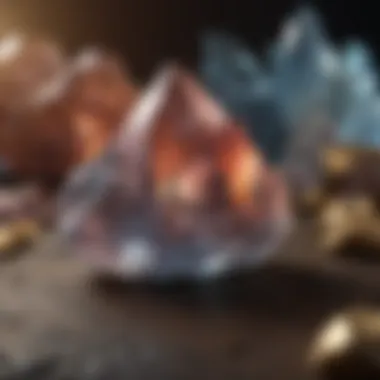
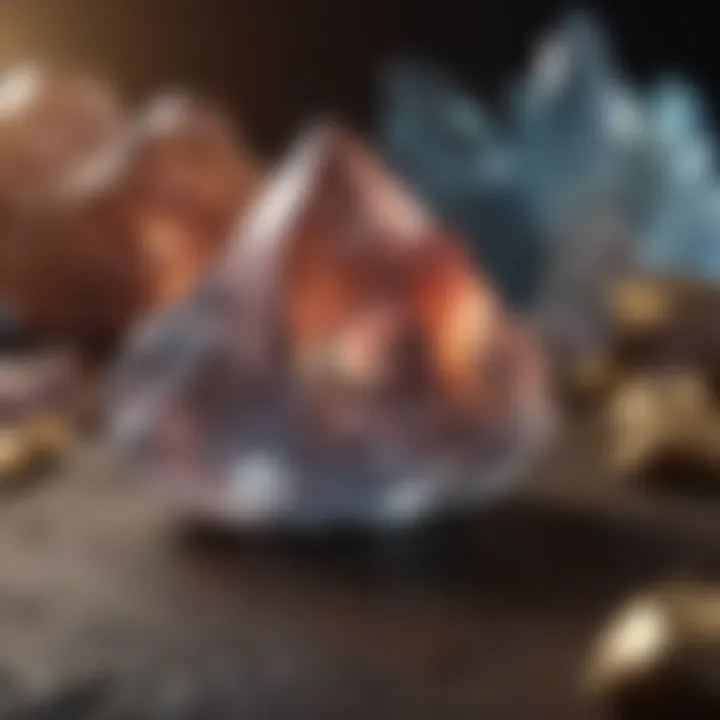
Cleansing Methods
Cleansing crystals is essential for clearing away any negative or stagnant energy that they might have collected. Think of it as a spa day for your stones—refreshing and renewing. Two popular methods of cleansing are water and salt techniques, and sound as well as moonlight. Each has its own special properties and suitability depending on the type of mineral you’re dealing with.
Water and Salt Techniques
Utilizing water and salt techniques is among the more straightforward cleansing methods, especially appealing to those who prefer a hands-on approach. The core idea sticks to the notion that water, much like our body, is a natural cleansing agent. When paired with salt, an earth element known for purification, you create a powerful combination.
Key characteristic: Saltwater helps in deep cleansing. It not only removes surface grime but also detoxifies the internal energy of the crystal. However, this method isn’t universally applicable; some crystals are softer or susceptible to damage from water, such as selenite or halite.
Unique feature: A notable advantage of this method is its availability and convenience. We often have water and salt at home, making it accessible. At the same time, it's vital to note that while some stones thrive with water cleansing, others can suffer serious detrimental effects. Therefore, always check the crystal’s characteristics beforehand!
Disadvantages: The risk of water damage looms large for certain crystals, making it a less wise choice in those instances.
Sound and Moonlight Cleansing
In contrast to the practical nature of water and salt methods, sound and moonlight cleansing offers a slightly more esoteric touch. Utilizing sound—whether through tuning forks, singing bowls, or even chanting—creates vibrations that can resonate with the energy of the crystals. According to various traditions, sound frequencies can shift the energy levels, promoting healing and restoration.
Key characteristic: This method is gentle and can be performed anywhere, ensuring that you don’t risk damaging your crystals while cleansing.
Unique feature: Moonlight cleansing is particularly cherished for its symbolic significance and connection to lunar cycles, believed to bestow subtle yet powerful energies. This method is especially suitable for those stones that appreciate a softer touch in terms of care.
Advantages: Not only does it cleanse the crystal, but it also imbues it with lunar energies, connecting the user more deeply to the natural world. However, it may require a fair bit of patience, as harnessing moonlight often necessitates leaving the crystals outside overnight.
Storing Crystals
The way one stores crystals can dramatically affect their vitality and energy. It's crucial to think critically about the environment where these stones are placed.
Consider the following points for effective storage:
- Avoid Sunlight: Too much direct sunlight can fade colors over time, especially for crystals like amethyst and citrine. Store them in a cool, dark area and consider using boxes that prevent light exposure.
- Separate Containers: Keeping crystals separated in soft bags or small boxes will prevent scratches and chips from occurring through contact with one another. If possible, use cotton or silk to wrap more fragile specimens.
- Organized Selection: Create a system that works for you, whether that means organizing crystals based on type, purpose, or energetic properties. This not only makes finding them easier but also allows you to connect with your collection more personally.
- Energy Calibration: Storing crystals near other energetically aligned stones can enhance their energies, but caution should be exercised as some minerals can produce adverse interactions.
As you dive deeper into the realm of healing crystals, remember that nurturing these pieces isn’t merely a chore; it’s a practice rich with intention. Just as you would tend to your well-being or your garden, your stones deserve that same level of care.
Debunking Myths About Healing Crystals
In the world of healing crystals, misconceptions and myths are more plentiful than stones in a riverbed. These misunderstandings often cloud the true potential of these geological wonders. It becomes essential to dismantle these myths to cultivate a more informed perspective on their benefits and applications. By doing so, we not only enhance our understanding but also empower ourselves to make educated choices in utilizing crystals.
Common Misconceptions
One of the primary misconceptions is that crystals have magical powers. Many tend to think that holding a crystal will instantly bring about change or healing. In reality, while crystals can have a positive impact, they work best as tools for personal energy alignment and meditative practices. They are like a key that can unlock doors to one’s inner self, yet one still has to be ready to walk through those doors.
Another common misunderstanding revolves around the belief that crystals are solely for a specific purpose. For instance, some folks say that rose quartz is only for love. In fact, it encourages emotional healing on multiple levels. This narrow view limits the potential of crystals to aid in various aspects of one’s life, making it crucial to share broader insights about their properties.
Scientific Critiques
Arguments Against Efficacy
Skeptics often argue against the efficacy of healing crystals. They cite a lack of empirical evidence supporting the claims about crystals’ healing abilities. This leads to a general belief that any positive experiences attributed to crystals are mere coincidences or manifestations of the placebo effect. What critics might overlook is the power of intention and personal belief, which can significantly impact an individual's state of mind. Moreover, the science of vibrational healing is still an evolving field. Thus, this argument, while it has its ground, doesn’t encompass the full picture.
This critique serves a beneficial role for our article by stressing the importance of seeking balanced viewpoints. When addressing arguments against efficacy, it encourages skepticism while also allowing space for personal experiences and anecdotal evidence. The unique feature of this critique lies in its potential to foster dialogue and research rather than to simply dismiss the topic.
The Role of Anecdotal Evidence
Anecdotal evidence plays a significant role in the conversation around healing crystals. Many practitioners and enthusiasts share their personal stories of how certain stones have positively influenced their lives. These stories, while not scientifically rigorous, carry weight in the communities that value subjective experience and personal growth. Anecdotal accounts can inspire curiosity and motivate others to explore the potential of crystals.
What makes anecdotal evidence an appealing choice within this article is its relatability. Readers can connect with personal stories, often finding parallels in their lives that resonate with their experiences. This can lead to a more profound interest in crystals, encouraging individuals to engage more fully with the content. However, it's essential also to remind readers that individual experiences can vary widely; what works for one person might not resonate with another.
Ultimately, debunking myths about healing crystals is pivotal for promoting clarity. It helps distinguish between what is superstition and what is worth considering in the realm of personal growth and healing. By navigating through these misconceptions, individuals can embark on their own journeys with crystals equipped with a more informed understanding, thus enriching the overall experience.
The End: The Continued Relevance of Healing Crystals
As we bring this exploration of healing crystals to a close, it becomes abundantly clear that these stones hold a unique position at the confluence of science and spirituality. The sustained interest in crystals over the years can be attributed to their multifaceted benefits, not just as physical objects but as symbols of deeper connections to both our inner selves and the broader universe.
One aspect of the relevance of healing crystals lies in their ability to be versatile tools for personal growth. People often turn to these stones during times of stress or transition. Just as one might seek comfort in a friend’s words, the therapeutic properties attributed to crystals can provide a sense of reassurance. From the calming energy of amethyst to the protective aura of black tourmaline, each crystal carries its own resonant frequency that contributes to emotional and spiritual wellness.
The Intersection of Science and Spirituality
When we consider the relationship between science and spirituality, healing crystals embody an intriguing narrative. The skepticism of the scientific community—traditionally focused on empirical evidence—contrasts sharply with the anecdotal experiences often associated with crystals. Yet, this intersection has begun to show signs of harmonization. Some researchers are delving into the vibrational properties of crystals, exploring how their unique molecular structures may influence energy fields around them.
- Vibrational frequencies of crystals are currently gaining attention from both alternative medicine practitioners and physicists.
- Likewise, studies on the placebo effect underscore that, regardless of how crystals are perceived, belief and intention can play a significant role in the healing process.
For example, consider the simple act of holding a crystal during meditation. This practice does not just hold a symbolic meaning; it could also enhance focus, allowing individuals to meditate more deeply. The act itself fosters a mind-body connection that can fundamentally alter one’s state of being. As more investigations are initiated in academic environments, we might witness the emergence of a coherent understanding of how crystals operate within human consciousness and physicality.
Future Directions in Crystal Research
Looking ahead, the future of crystal research appears quite promising. The emergence of interdisciplinary studies integrating geology, psychology, and alternative healing could yield new insights into the efficacy of crystals. Questions remain abundant:
- How might different types of minerals influence their purported benefits?
- Is there a connection between a crystal’s geological formation and its healing properties?
- Can rigorous scientific experimentation lend credence to the claims made by users of crystals?
With the growing interest in holistic healing methods, scholars are likely to devote more attention to these queries.
In summary, healing crystals continue to resonate with individuals seeking connection and understanding in a chaotic world. Their relevance endures, driven by the inherent human desire to explore the deeper intricacies of life, whether through scientific inquiry or spiritual exploration. The ongoing dialogue between these realms promises to enrich our knowledge of both crystals and ourselves.



